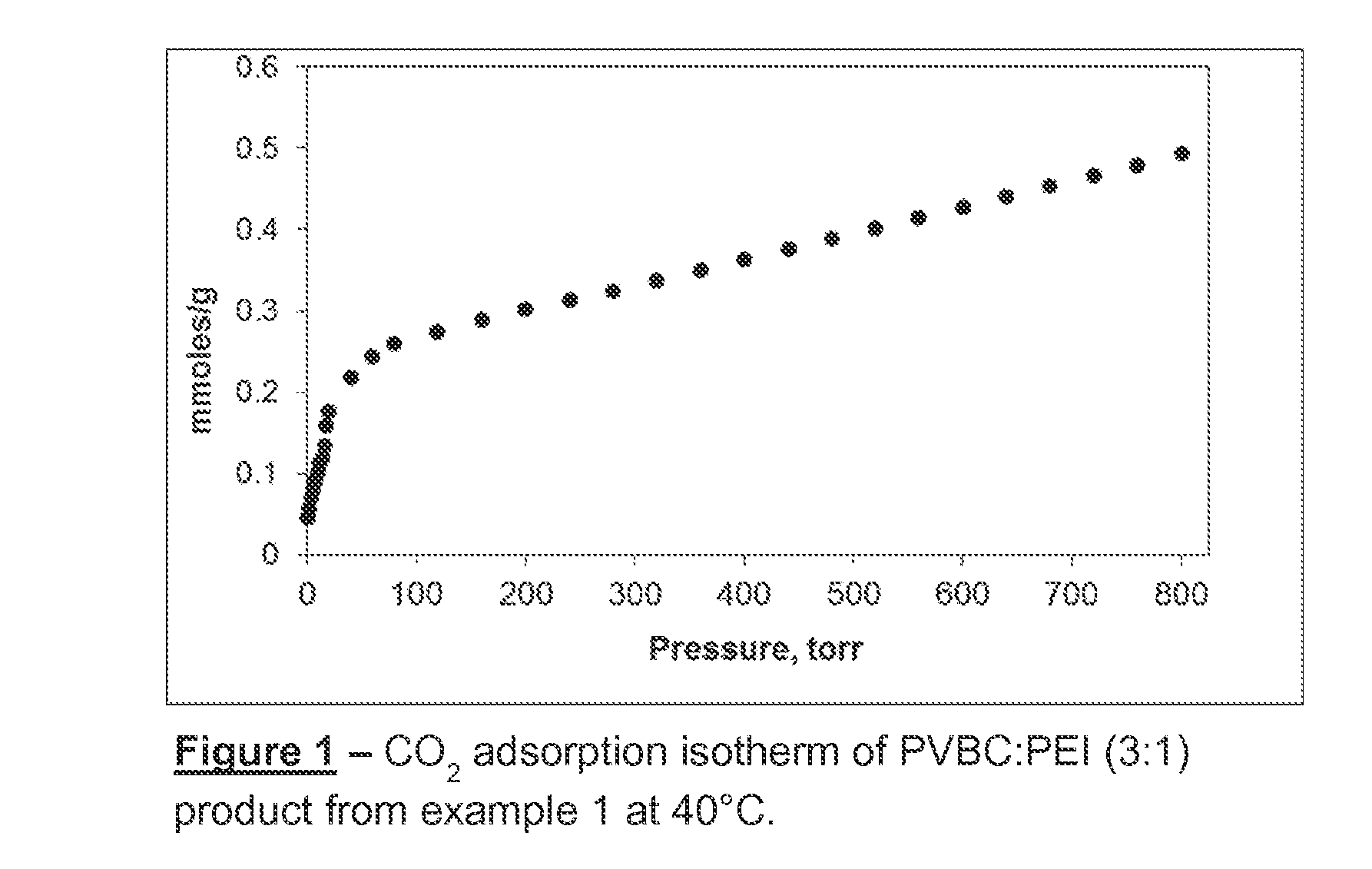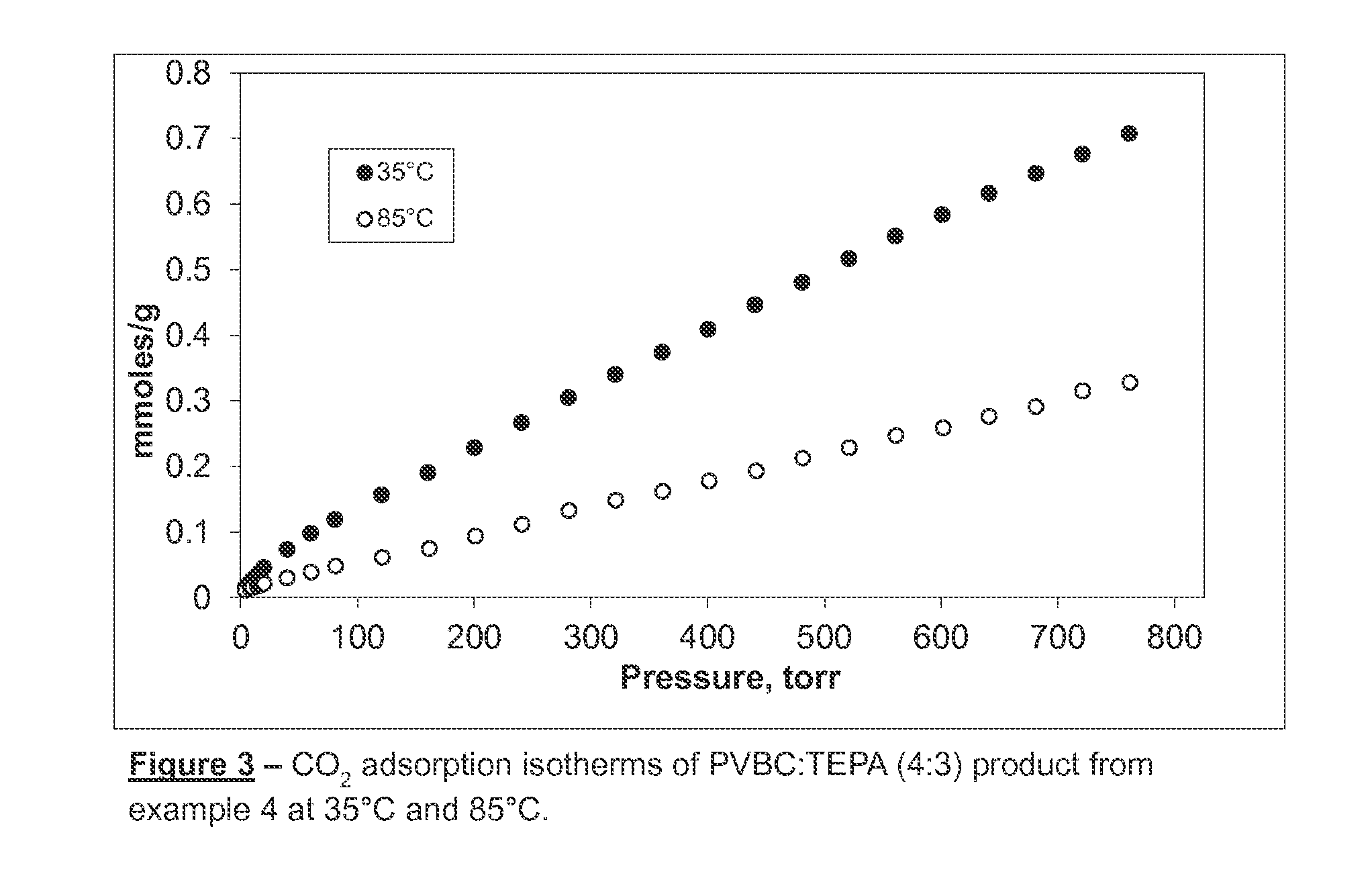Polyvinyl-Amine Acid Gas Adsorption-Desorption Polymers, Processes for Preparing Same, and Uses Thereof
a technology of polyvinylamine acid and gas adsorption, which is applied in the field of adsorption desorption materials, can solve the problems of high equipment and energy costs, high gas-liquid exchange rate, and large temperature drop of the gas stream, and achieve low capital cost, low pressure, and low propensity for corrosion
- Summary
- Abstract
- Description
- Claims
- Application Information
AI Technical Summary
Benefits of technology
Problems solved by technology
Method used
Image
Examples
example 1
Preparation of 3:1 PVBC:PEI
[0098]1.5 g of PVBC was dissolved in 48.5 ml dry toluene under a nitrogen gas purge. Subsequently, 2.94 g (2.8 ml) of PEI (Mn˜600 g / mol) was added with continual mixing at 50° C. Almost immediately after the addition of PEI the initially clear solution began to turn cloudy. White precipitate also appeared. Within approximately 2.5 hours the solution had a gel-like consistency. After stirring overnight, the toluene solvent was evaporated in vacuum. The material was washed with acetone for 30 minutes, and then neutralized with NaOH / methanol solution (2%) for one hour. The material was filtered and washed again with deionized water and acetone. Finally, the product was dried at 50° C. under vacuum for approximately 12 hours.
example 2
Preparation of 2:1 PVBC:TEPA
[0099]1.5 g of PVBC was dissolved in 48.5 ml dry toluene under a nitrogen gas purge. Subsequently, 0.93 ml of TEPA was added dropwise with continual mixing at room temperature. Almost immediately after the addition of TEPA the initially clear solution began to turn cloudy. After overnight stirring, a cloudy suspension had formed. The solvent was removed by vacuum evaporation. The polymer was washed with acetone. The material was then neutralized with NaOH / methanol solution (2%) for 10 minutes under continual agitation. The solvent was decanted and the material was filtered and washed again with deionized water and acetone. Finally, the product was dried at room temperature under vacuum for approximately 12 hours.
example 3
Preparation of 1:1 PVBC:TEPA
[0100]1.5 g of PVBC, was dissolved in 48.5 ml dry toluene under a nitrogen gas purge. Subsequently, 1.86 g of TEPA was added dropwise with continual mixing at room temperature. Almost immediately after the addition of TEPA the initially clear solution began to turn cloudy. Overnight stirring produced a fine suspension. The solvent was removed by vacuum evaporation. The polymer was washed with acetone. The material was then neutralized with NaOH / methanol solution (2%) for 1 hour under continual agitation. The solvent was decanted, then the material was filtered and washed again with deionized water and acetone. Finally, the product was dried at 56° C. under vacuum for approximately 12 hours.
PUM
| Property | Measurement | Unit |
|---|---|---|
| particle diameter | aaaaa | aaaaa |
| temperature | aaaaa | aaaaa |
| pressure | aaaaa | aaaaa |
Abstract
Description
Claims
Application Information
 Login to View More
Login to View More - R&D
- Intellectual Property
- Life Sciences
- Materials
- Tech Scout
- Unparalleled Data Quality
- Higher Quality Content
- 60% Fewer Hallucinations
Browse by: Latest US Patents, China's latest patents, Technical Efficacy Thesaurus, Application Domain, Technology Topic, Popular Technical Reports.
© 2025 PatSnap. All rights reserved.Legal|Privacy policy|Modern Slavery Act Transparency Statement|Sitemap|About US| Contact US: help@patsnap.com



